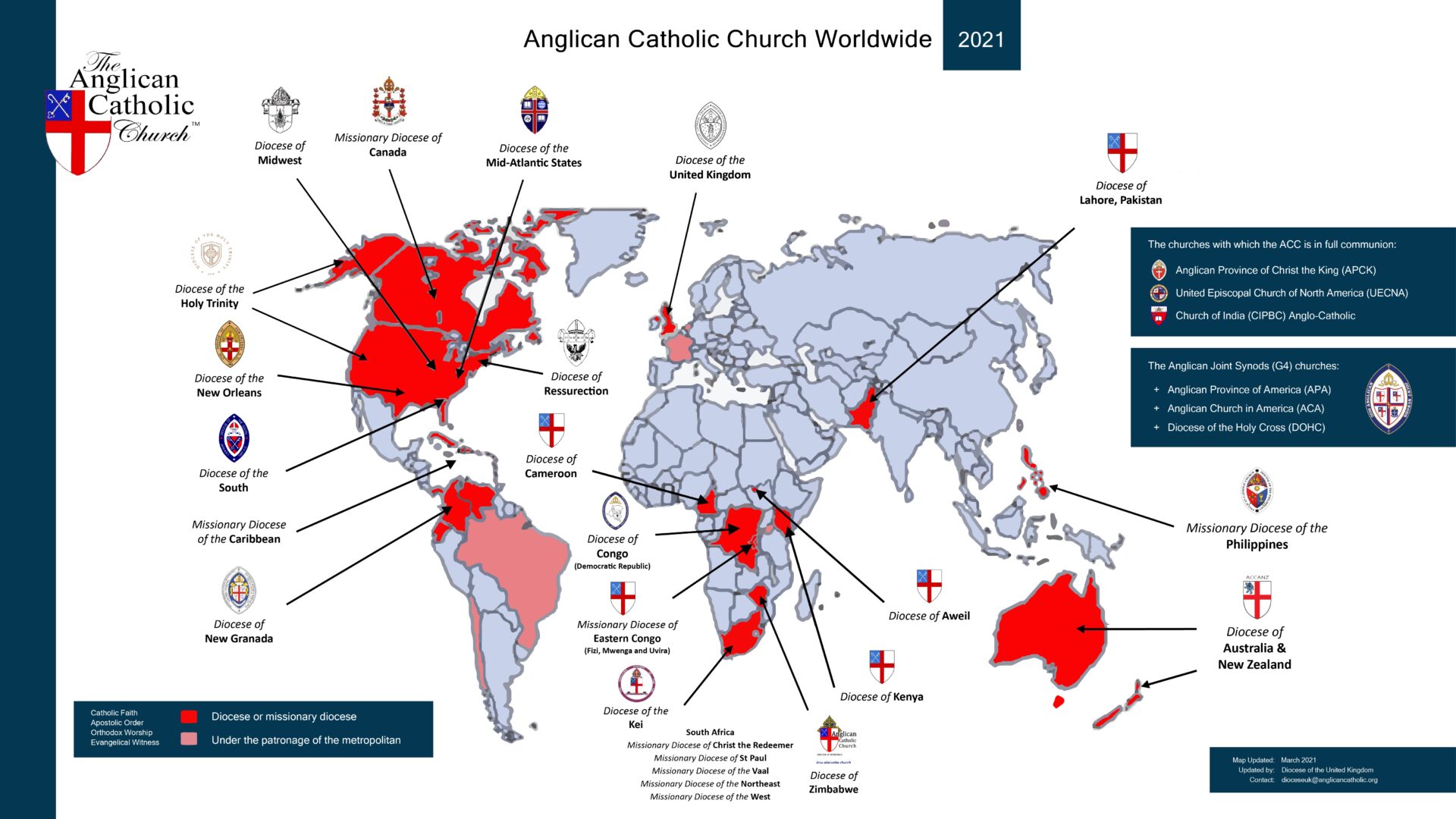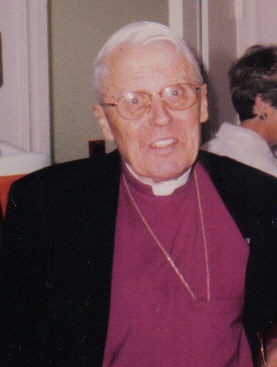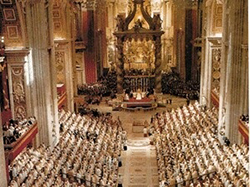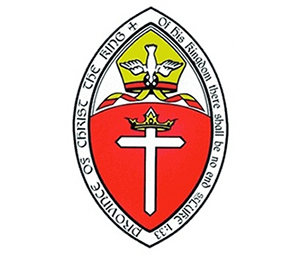What is the ACC?
The Beginning of the ACC
The Rt Revd James Orin Mote
On January 28, 1978, in Denver, Colorado, Father Mote was consecrated Bishop. The Rt. Rev. Albert A Chambers, retired Episcopal Bishop of Springfield, Illinois, was chief consecrator.
In 1977, following increasing changes to the liturgy, faith and practice of member churches of the Anglican Communion, an international congress of nearly 2,000 Anglican bishops, clergy and lay people met in St. Louis, Missouri. As a result of this meeting “The Affirmation of St Louis” was formulated and published.
In addition many of those present placed themselves under the jurisdiction of the retired bishop of Springfield, Illinois, the Right Reverend Albert Chambers. In October 1978 the Church adopted the name ‘ANGLICAN CATHOLIC CHURCH’. The ACC has a presence in North, Central and South America, Africa, Australia and New Zealand and in India you will find the Second Province of the ACC. (Click on the Map above to see the ACC world wide).
Diocese of the United Kingdom
In August 1992 The Right Revd Leslie Hamlett was consecrated as the first Bishop Ordinary for the Diocese, in 1997 Bishop Hamlett left the ACC.
From 1997 to 2008 the Diocese was overseen by the Diocesan Council of Advice acting as Guardians of the Spiritualities and an Episcopal Visitor, that is, one of the bishops of the Original Province appointed by the Metropolitan Archbishop.
On 20th September 2008 Father Damien Mead, who was Vicar General, was consecrated as second Bishop Ordinary.
Click Here to view a short clip of Bishop Mead’s Consecration Service (via Youtube)
The Succession of Bishops in the Anglican Catholic Church can be traced here:
Click Here to view The “Chambers” Succession of ACC Bishops
The Bishop is assisted in the administration of the Diocese by his Council of Advice which is appointed annually at the Diocesan Synod. The Diocese of the United Kingdom is divided into two Deaneries; North and South and each has a Dean appointed by the Bishop for a three year term. In addition the Diocese also has an Archdeacon, who is, the senior clergyman, also appointed for a three year term.
Our Diocesan Bishops 1992 – 1997 & 2008 – Present


The Right Revd Damien Mead
Our Episcopal Visitors 1997 – 2008
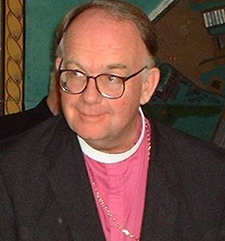

Most Rev Mark Haverland

From 1997 until 2008 the Diocese of the United Kingdom was looked after by Episcopal Visitors appointed by the Archbishop of the Original Province from Bishops overseas. (pictured above)
Why Anglican & Catholic?
The Anglican Catholic Church is Anglican, which means ‘English’. In other words, we are Christians who have an English liturgical and theological heritage and a spiritual heritage and an ancestral connection to the Church in England. The Anglican Catholic Church is Catholic, because it accepts the doctrine of the ancient Church, which has been “believed everywhere, always, and by all”.
But aren’t you Protestants?
The terms ‘Protestant’ and ‘Catholic’ are often used and very often misunderstood!
Firstly one must understand that to be ‘Catholic’ one doesn’t necessarily have to be ‘Roman’ Catholic despite what some may believe or claim. The Orthodox Churches of the East and in other places are Catholic Churches but not in communion with the Pope. The term protestant is equally often misunderstood.
The Catholic Church of England separated from the Roman Catholic Church during the sixteenth century. However, although a Protestant Reformation was taking place on the Continent the English Reformation was fundamentally different in nature and intention. Primarily the reasons for its formation were political. King Henry VIII, whilst wanting to be independent of Rome, was not a Protestant in intention, although his reasons for separation were not especially honourable.
Of course there are Anglicans who have wanted to be Protestant (in the way that continental reformers meant), just as there are Anglicans who want complete union with Rome. However, the Church of England was not formed in the same way as the Continental Protestant Churches. The Continental Reformation was primarily German, under the leadership of Martin Luther; French, under John Calvin and Swiss, under Ulrich Zwingli. The Continental Reformers accepted the principle called Sola Scriptura, that is, Scripture alone as the basis for faith and practice. However, the English Reformers appealed to Scripture as interpreted by the ancient Church, especially through the Seven Ecumenical Councils of the Undivided Church. The Continental Reformers also almost unanimously rejected or dropped the principle of apostolic succession. That is, bishops, by virtue of their consecration, being successors of the apostles, tracing a straight link back to them through history. But the English Reformation retained apostolic succession.
Since the Continental Reformers rejected the apostolic succession of bishops and indeed developed a different understanding of the priesthood, they lost a ‘valid’ ordained priesthood. But at the English Reformation, the Church of England deliberately retained the title ‘priest’, because it contained a real truth and intention. Christ is the perfect priest. The Church is His body. The organ of a priestly body cannot be less than priestly.
The Church of England maintained its apostolic ministry of bishops, priests and deacons. Its form of worship, though translated into English and somewhat reformed, nonetheless stood in continuity with the Church’s historical worship. The goal of the English Reformation was to reform the practice of the Church and return to the ancient and Catholic faith of the Undivided Church.
(Click on the individual pictures below for information about each notable Anglican)

JOHN HENRY NEWMAN

WILLIAM LAUD

LANCELOT ANDREWES

GEORGE HERBERT
From the time of Henry VIII there has always been a theological position within Anglicanism which has sought to stress the continuing Catholic nature of the Church of England. Through the reign of his daughter Elizabeth I this was championed by the Elizabethan divine, Richard Hooker. Then later by Archbishop Laud and the Caroline divines including George Herbert and Lancelot Andrewes (pictured above), up to the time of the Oxford Movement, Tractarians, and the Anglo-Catholic Congresses, notables include John Henry Newman, Edward Bouverie Pusey, John Keble and John Mason Neale (pictured below).

RICHARD HOOKER

EDWARD BOUVERIE PUSEY

JOHN KEBLE

JOHN MASON NEAL
What do Anglican Catholics believe?
The Anglican Catholic Church accepts the teachings of the Undivided Church, the Church of the first millennium of Church history. From the Day of Pentecost, when the Church was born, to the Great Schism in A.D. 1054, the Church was truly Catholic: one in faith and doctrine, even though there were differences between the way Eastern and Western Churches worshipped. Therefore, the Anglican Catholic Church claims, in essence, to be both an English Catholic Church and a Western Orthodox Church.
The Anglican Catholic Church is part of the One, Holy, Catholic, and Apostolic Church of the Lord Jesus Christ, faithfully continuing the English Catholic tradition. We practice and uphold the historic Catholic Faith, with Apostolic Order, Orthodox Worship, and Evangelical Witness.
We believe that there is one true and eternal God in Holy Trinity of Father, Son, and Holy Ghost, without any difference or inequality, Consubstantial, Undivided and of one Essence in Three Divine Persons through whom all that is, was and ever shall be, was created and has its being.
We believe that Jesus Christ is the unique and final revelation of the Person and Purpose of God, in whom alone is the fullness of God’s truth and grace, and that there is no other through whom salvation may be obtained.
Holy Scripture, the Holy Spirit & Holy Tradition
We believe in the Communion of Saints, which is the blessed company of all faithful people both living and departed. Traditionally the Universal Church has been considered to comprise of the Church Triumphant (those Christians who are in Heaven), The Church Militant (those Christians who are living) and the Church at Rest (Those Christians who are dead but who are not yet in Heaven).
Furthermore we believe that the Blessed Virgin Mary is the Mother of our Lord and God Jesus Christ, and that she is preeminent above all others as the first-fruits of those who are saved by Him. Simple reasoning from the facts shows us very clearly that Mary is the Mother of God: Mary is the Mother of Jesus; Jesus is God; therefore, Mary is the Mother of God. To say otherwise denies the divinity of Christ. Further, Mary is the Mother of Jesus; Jesus is King of Heaven; the mother of a king is a Queen Mother; therefore, Mary is the Queen of Heaven being the Queen Mother. This is why we hold this woman in such high regard and venerate her: she stands so close to her son – the Son we Worship. Please note: we do not worship Mary – we venerate her as one would a Queen Mother. She is human in a single nature as we are and therefore not worthy of the worship we would pay to God, but nonetheless, we venerate her on account of her son, His being and His actions.
The prayers of the saints in heaven assist the faithful on earth according to the Revelation of St John (Revelation 5:8 and 8:3-4 in the light of 6:9-11). The Saints are not to be given worship or adoration that belongs to God alone, but their prayers support Christians on earth just as the prayers of Christians on earth support one another in prayer). There are so many holy people who enjoy the eternal fellowship with God and whose lives have allowed the goodness of God to ripple throughout Time. Just as our sins affect our children negatively, so do the good deeds of the saints affect them positively because these deeds have their source in God.
We believe in Seven Sacraments
We believe in the Seven Sacraments as outward, visible symbols of the inward, spiritual Grace, Presence and working of our Lord Jesus Christ. In accordance with the faith and practice of Holy Mother Church, We declare these Sacraments to be:

BAPTISM

CONFIRMATION

HOLY COMMUNION

MATRIMONY

PENANCE

HOLY ORDERS

HOLY UNCTION
Please note: The ACC commitment to the ancient practice of the male-only priesthood is not a dismissal of the Christian ministry of women, but an obedience to God and an affirmation that Christ came as a man to be the High Priest whose sacrifice brings us back to God. Galatians 3:28 demonstrates clearly that men and women are of equally infinite worth to God; that they receive the same salvation and incorporation into the Church as the Body of Christ; and that they deserve equally the respect and veneration that Christian Love demands. However, the fact of the creation of men and women as being distinct within the human species, with different physiology and genetics, means that they cannot be interchangeable. Such interchangeability denies the integrity of Man as much as it does Woman.
While we, in common with historic and apostolic practice and with the vast majority of Christendom today, women cannot be ordained for the priestly ministry, their particular ministry and vocation are of such great value. One only has to look at St Hilda of Whitby, St Catherine of Siena, St Hildegard of Bingen and St Theresa of Calcutta for the truth of that!
Two books, written by The Very Revd Dr Jonathan Munn, Obl/OSB, the Secretary to our Diocesan Board of Ministry, helpfully explore this matter further. They can be purchased directly from the publisher by clicking on the following links:
Sanctity of Human Life
We believe that all men will appear before Our Lord Jesus Christ, who is the ultimate Judge and Ruler of all Mankind to receive the due recompense of their faith and works.
We believe in the sanctity of human life and that life begins at the moment of conception. When we look at people, we see human beings, each individuals created by God in His image, each individuals of infinite worth and deserving love, dignity and respect which they possess indelibly from the moment that they come to be in the womb to their last breath and, even further, when they pass from this life into the Great Beyond. We do believe that the wilful taking of that life in the womb by abortion to be a grave sin because it is the ending of an innocent life according to the law of God. However, we recognise that there are extremely difficult situations which arise which make it almost impossible to avoid sin without immense sacrifice. Our duty as a Church is to be compassionate and to pray for all involved, offering, wherever possible, practical help, advice and support.
Furthermore we believe that the wilful, intentional, and direct taking of any innocent human life is murder, whether described as “euthanasia”, “mercy-killing” or “assisted suicide”. We cannot make exceptions to what God has decreed but, again, we commit in prayer these hard cases to God for His guidance, love and tender care that go beyond what any one of us can actually comprehend.
But didn’t the Pope declare Anglican Holy Orders null and void?
In response to Pope Leo XIII’s Apostolicae Curae of 1896, which declared the Anglican apostolic succession invalid, the Anglican Archbishops of Canterbury, Frederick Temple and York, William D Maclagan, (pictured above) made an official response, Saepius Officio, stating that there is an unbroken apostolic succession in the Anglican priesthood, and that the historical episcopate has been in the British Isles from the earliest days of the Church.

POPE LEO XIII

FREDERICK TEMPLE

WILLIAM DALRYMPLE MACLAGAN
However, the Roman Catholic Church maintains that this apostolic succession was broken by the use of the Ordination Rite of King Edward VI, which deletes all reference to the central priestly function and was deliberately designed to contain no indication of the “fullness of the ministry”, specific tasks of the Catholic bishop or the “high priesthood”, which the Holy See considers essential. The Romans assume that their point of view, based on Late Medieval sacramental theory, is valid for all periods of church history.
In their refutation the Archbishops pointed out, amongst other matters, that no such priestly functions or sacramental theology were evident in the Papal ordination rites of the 9th and 10th centuries, which would render their ordinations invalid as well, using the same criteria aimed at the Anglicans.
Apostolic Succession in the Anglican Catholic Church
The ACC has taken great steps to preserve the apostolic succession we have received. We do not possess Orders of our own. Our Orders are derived from the one holy, catholic and apostolic Church, via the Church of England, the Scottish Episcopal Church and the Episcopal Church of the United States of America.
The correct and proper celebration of all the sacraments including the ordination of deacons, priests and bishops have always been considered of primary importance. Not least because, as we are reminded in the Gospel, we should “Seek … first the kingdom of God and his righteousness” (Matthew 6: 33). To do so we need to be assured that we are truly part of the one holy catholic and apostolic Church, so that we can “take no thought for the morrow” and rest secure in our faith and great hope.
Sometimes, uninformed people question the legitimacy of the holy orders of ordained ministry (deacon, priest and bishop) in the Anglican Catholic Church. Because of our beginnings in North America, the ACC has sometimes been dismissed as simply an “American breakaway group” or has been lumped together with so many other small groups and ecclesial jurisdictions, who all claim legitimacy but who are more often than not surrounded by varying degrees of confusion and in many cases caution is warranted.
The current Bishop of the Diocese of the United Kingdom, and our Rector at St Augustine’s, is the Right Reverend Damien Mead, who was elected by th Synod of the Diocese of the United Kingdom in March 2008, and who was consecrated on 20th September 2008 in the Chapel of St Augustine’s College, Westgate on Sea, Kent, formerly a Roman Catholic Convent and School, as a bishop in the Church of God, according to the rites of the Anglican Catholic Church, namely the historic Book of Common Prayer.

Bishop Mead’s Chief Consecrator, acting under the authority of the Metropolitan Archbishop, was the Right Reverend Rommie Starks, the ACC Bishop of Indianapolis and the Diocese of the Midwest, USA, He was assisted by the, late, Right Reverend Arthur Roger Dawson, retired ACC Bishop of Caracas, Venezuela and the Right Reverend Denis Hodge, ACC Bishop of New Zealand.

In addition to the “Chambers Line” of succession, Bishop Mead’s chief consecrator, had himself had, as one of his own consecrators, the former Church of England bishop, the Right Reverend John Charles (Vockler), FODC. (pictured left) sometime Assistant Bishop of Adelaide, Australia, Bishop Ordinary of Polynesia, Assistant Bishop in the Church of England Dioceses of Chelmsford and later Southwark and, before joining the ACC, Assistant Bishop in the Diocese of Quincy’ within the Episcopal Church of the United States of America.
Click Here to view the ACC “Chambers Succession” and more information.
What about the authority of the Pope?
Since we have stated that the Anglican Catholic Church is not a ‘Roman’ but an ‘English’ Catholic Church it will come as no surprise that we do not consider ourselves to be under the Bishop of Rome’s ‘Universal Jurisdiction’. Again our position is comparable to the practice of the Undivided Church.
Furthermore the Pope claims to be infallible in certain matters. Anglican Catholics believe in infallibility, but they believe that it is found not within the Office of the Pope, but within the Church itself, and that this is best expressed when it is acting as an undivided unity through the medium of the Ecumenical Councils. But since A.D. 1054 this hasn’t happened. As a result the pronouncements and decisions of Church Council’s within the Roman Catholic Church, such as the Council of Trent, Vatican I and Vatican II are not considered to have the same authority.
We do however recognise and give due honour to the Pope as Bishop of Rome and as Patriarch of the West on the ancient principle of primus inter pares. He is the ‘first among equals’ in the episcopate and has a special role and responsibility because of this.
Communio in Sacris

An exciting and important recent development is the coming together of four of the largest traditional Anglican Churches into full communio in sacris.
The historic agreement confirming this was signed in the presence of over 550 clergy and lay delegates by the leaders of the Anglican Catholic Church (ACC), the Anglican Church in America (ACA), the Anglican Province of America (APA) and the Diocese of the Holy Cross (DHC) on October 6th 2017 in Atlanta, Georgia, some forty years after orthodox Church representatives signed the Affirmation of Saint Louis, which called for the creation of the Continuing Anglican Church.
Click this link for the Anglican Church in America Website
Click this link for the Anglican Province of America Website
Click here for the link to the Diocese of the Holy Cross.
Which Liturgy?
As you will see from this website, at the time of writing the Diocese of the United Kingdom has only a small number of Parishes and Missions. In these congregations you will find a variety of use in authorised Liturgies (Orders of Service) for celebrating Holy Communion.
The Book of Common Prayer (BCP) is used for the Daily Offices of Morning and Evening Prayer. The Order for Holy Communion (Commonly called ‘The Mass’) is from either the ‘English Missal’ or the ‘Anglican Missal’. The Order in the ‘English Missal’ uses the Eucharistic Prayer known as the ‘Gregorian (or sometimes called the ‘Roman’) Canon’. The Anglican Missal may be found to be celebrated with either the ‘1549 BCP Canon’, the ‘American 1928 BCP Canon’ or the ‘Gregorian Canon’.
All of our services are conducted in ‘traditional English’ and the liturgical readings from Holy Scripture are taken from the Authorised (King James) Version of the Bible. Hymns are sung at some of our services and these are usually taken from the English Hymnal.
Sometimes our liturgical use in this Diocese – being predominantly ‘High Church’ or ‘Anglo Catholic’, is suggested to be off putting to those who come from a more ‘middle of the road’ or from a ‘Low Church’ Anglican liturgical tradition.
It would be true to say that we are representative of the people who have taken the step to commit themselves and join us. We are, however, very much open to the establishment of new Missions using other ACC authorised liturgies in the Diocese.
It is our faith that unites us and if you share this faith, or seek to, you are welcome.
The future?
To all, and especially those of you who having waded through this page of text, we extend a hand of friendship and Christian Love and offer you an alternative – Please consider seriously the challenges presented to you and we hope that you will join us.
Join us …
In the ACC we have the essentials. We have, as the Affirmation of St Louis puts it, Orthodox Catholic Faith, Orthodox Anglican Worship, Apostolic Catholic Order in order to grow we need also Evangelical Witness.



